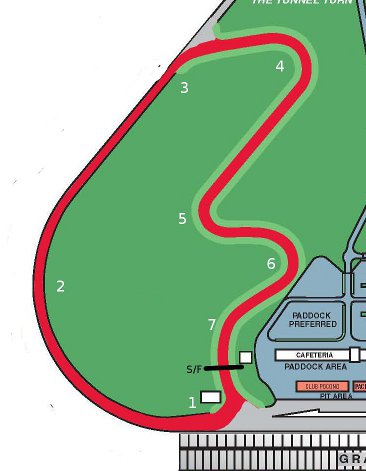Pocono North Track Guide
Published: September 11, 2013
This configuration uses the North course infield, run clockwise, and Nascar turn 3. Its official length is 1.5 miles.
Turn By Turn
There appears to be no official start/finish position on the North course. This is probably because there is no timing loop buried on the North course, therefore each organizer places the timing loop themselves and thus determines where turn numbering begins. For time trials, start/finish is typically located just before pit entrance. For racers, start/finish is typically on the oval past the pit exit. In non-competition events the turn numbers can begin anywhere. I will use time trial corner numbering, with turn 1 being infield into the oval turn.
Turn 1
The most important corner on the track, leading onto the oval. Exit speed here is crucial.
This corner has been flattened during the 2013 repaving and can, and should, now be taken flat out from the turn in.
Brake and downshift, if needed, before the turn in point, which is the tire stack on the left. As soon as you are facing the apex, floor the throttle.
Use the entire track width. Track out to within 1-2 feet of the outside wall.
Turn 2
The Nascar turn 3, taken clockwise. This turn should be taken flat out in pretty much any car. Low and medium horsepower cars should dive for the inside edge of the track as soon as they are finished with turn 1 and follow the inside edge through the entire turn.
Turn 3
Signature Pocono oval into infield transition. This turn is very fast with entry speeds exceeding 100 mph. In 2013 the transition is quite rough, especially for stiffly sprung cars with limited suspension travel. Cars with street suspensions, especially with novice or intermediate drivers, almost do not notice the transition.
Less experienced drivers typically drive a late apex, braking on the oval parallel to the wall, rotating the car substantially at their turn in point and crossing the transition approximately 1/3 of the track width off the apex.
A faster line which also happens to be vertically flatter is to do very little or no braking on the oval and turn in very gently much earlier, then put the car right on the apex and land facing the turn in point for turn 4. Brake hard in a straight line in the short straight between turns 3 and 4.
Turn 4
A fairly fast but decreasing radius right hander. After the 2013 repaving the turn is wider but is still of decreasing radius.
Because the turn is of decreasing radius, care needs to be taken to not run out of track at the exit when driving aggressively.
Turn 5
A slow left.
This turn has a somewhat earlier apex than might initially appear. Care should be taken not to enter it too late. Be sure to touch the apex curbing at some point.
If you do not need the entire track width at the exit, you should typically carry more speed into this turn.
Turn 6
A tricky right hander. This turn is faster than turn 5, but just about all cars have to brake for it. It also has a narrower exit compared to its entrance, making it similar to a decreasing radius turn. At the same time this turn leads to what is effectively a straight between turns 6 and 8, making exit speed important. The trickiness of turn 6 is absence of obvious reference points to use for braking and turn in.
There is a paint mark somewhat right of center in what is the braking zone for most cars that can be used as a turn in reference point. Essentially the turn is a late apex and requires patience. Most cars do not need to enter this turn from extreme left, however it may help. Experiment.
Turn 6 is also off camber, and not far from a guard rail. Going off at speed in this corner has high likelihood of putting the car into said guard rail, especially in wet conditions.
Turn 7
A left kink that most cars with low to medium horsepower should take flat out. A late apex is required to drive through it flat out, which in turn requires proper vision and planning when exiting turn 6.
The goal should be to drive the straight between turns 7 and 1 on the left side of the track as much as possible.
Rain Lines
The curbs are very tall and square wave shaped, therefore drain rather well. In a steady wet condition putting the car as much over the curbs as possible, which literally means having half of the car width travel over the curb, is worth quite a bit of lap time. Significant elevation of the inside wheels helps load the outside wheels as well.
In a heavy rain a river tends to form right before the apex of turn 1.
Prior to the 2013 repaving a lake tended to form on the outside past the apex of turn 6.
With the new pavement in 2013, there are no slick parts of the surface yet. Drive where there is no standing water. The fastest line is frequently the line that everyone is driving simply because it is drier.
Passing Zones
If passing zones are used, they are the entire length of the Nascar oval between turns 1 and 3 and the infield straight between turns 4 and 5.
Other Resources
Lap Records
2013 repave widened the track as well as made it grippier. Pre-2013 lap records can probably drop by 1-2 seconds.

 Visit our
Visit our